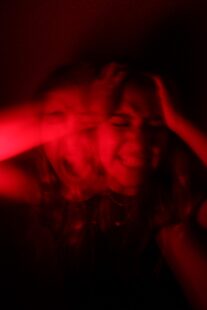Managing Manic Bipolar Episodes
Nathan Ainley
Bipolar disorder is an incurable condition that is classified as a mood spectrum disorder. This means that a person with bipolar will experience dramatic mood swings that last for significant periods, known as episodes. These episodes range between a low mood called a depressive state (or simply depression), and a high mood called hypomania or mania.
 The frequency of occurrence and intensity of each episode varies from person to person and may last a day or might last months. While it is not treatable or curable, bipolar can be manageable with the right combination of medication and therapy.
The frequency of occurrence and intensity of each episode varies from person to person and may last a day or might last months. While it is not treatable or curable, bipolar can be manageable with the right combination of medication and therapy.
Many people who have bipolar disorder are undiagnosed, and most are unaware of the effect their mood swings have on those closest to them. Besides affecting relationships, depressive or manic episodes affect work, studies, and daily life. It is important to be able to determine what constitutes a manic episode so that you can seek help for future occurrences.
The Highs and Lows of Bipolar: Depression and Mania
Every person will experience mood swings and alternating outlooks, some more turbulent than others. There may be a variety of factors influencing the swing, but overall, it is healthy to fluctuate somewhat in your mental health state.
To some degree, we all have control over our moods or at least an idea of what is influencing them. A person with bipolar, however, might wake up one day feeling low in energy and miserable without fully knowing why. This mood might worsen to the point of them not wanting to leave their bed for any reason.
Bipolar used to be called “manic depression” until it was determined that there is more nuance involved than with other manic-depressive illnesses. A depressive episode in bipolar looks exactly like clinical depression.
During a depressive episode, a person will feel depleted of energy and enthusiasm, might be teary and emotional, will suffer from low self-esteem may have dark thoughts, and even attempt self-harm. In addition, they may experience weight loss, insomnia (or sleeping too much), irritability, indecisiveness, and unwarranted guilt.
 Treatment for depressive episodes is commonly done by way of the same medication as non-bipolar-related depression, by way of mood stabilizing drugs or antipsychotics. This ensures a relatively quick change in mood and outlook, although it may take some time to get the correct medication and levels of dosage. With bipolar, a depressive episode commonly comes on the back of a manic one.
Treatment for depressive episodes is commonly done by way of the same medication as non-bipolar-related depression, by way of mood stabilizing drugs or antipsychotics. This ensures a relatively quick change in mood and outlook, although it may take some time to get the correct medication and levels of dosage. With bipolar, a depressive episode commonly comes on the back of a manic one.
There are two types of manic episodes and each one is distinct, although both have the same symptoms. Hypomania is a less dramatic occurrence of mania and may persist for only a day or may be present for up to four days at most. It is not disruptive and does not require hospitalization or time off from work. Mania, on the other hand, is severe and causes significant functional impairment.
Mania is the opposite of depression, meaning that a person is filled with energy, optimism, euphoria, and boldness. Manic episodes generally feel invigorating and liberating, and a person with bipolar might truly enjoy the experience.
Mania can also result in extreme irritability and aggression and may be interspersed with bouts of depression. Manic episodes can resemble schizophrenia and might result in psychosis (becoming detached from reality), requiring hospitalization, medication, and close monitoring.
Symptoms of a Manic Episode
In some cases, there are warning signs that a manic episode is approaching. This could look like a decreased need for sleep, a decreased appetite, increased talkativeness, and unexpected or uncharacteristic generosity.
A person about to experience a manic episode might begin giving away money or possessions, make extravagant purchases, or become uncharacteristically promiscuous in their sexual choices. This out-of-character behavior might only be noticeable to loved ones and close friends.
There may be a trigger that induces mania, such as an intimate encounter, or a particularly thrilling moment. In any case, all their behavior becomes so exaggerated that it is impossible to ignore.
During mania, a person may work themselves up with so much excitement that they begin to foam at the mouth, become unfocused, and not be able to follow a logical conversation. Body language becomes tense, and they may appear to be thoroughly agitated. In some cases, they will become violent and pose an obvious physical threat. In this state, they may attempt an absurd and impossible feat like flying, putting themselves at risk of death.
All this behavior comes from an exaggerated spike in energy, confidence, and euphoria. During a manic episode, some people slip into grandiose delusions, proclaiming themselves as royal or famous, and genuinely believing it to be true. Some have been known to display truly remarkable feats of strength, accomplishing things that they wouldn’t be capable of in a subdued state.
With all the build-up of energy they experience, it becomes vital for them to express it, and this commonly leads to them having moments of shouting, singing, and wrecking furniture.
This behavior can be distressing to loved ones observing it, especially spouses, partners, parents, or children of the bipolar person in their manic state. This is one reason why it is important to have some professional insight into bipolar disorder is important. Knowing what could potentially happen to a loved one in a manic state prepares you for some of the more alarming aspects of mania.
The Aftershock
If allowed to continue, a manic episode might last for anything between two days and a few weeks. Often the behavior during a manic episode becomes so extreme that it warrants intervention, and most people are hospitalized or medically subdued during mania.
A manic episode will always give way to depression, because as the saying goes, “What goes up must come down.” The comedown after a manic episode can be a dark time for a person with bipolar. Most people are medicated for it if there is access to mental healthcare. Placing the person on a suicide watch is often vital at this point.
 Without the aid of medication, this can be the single worst moment in dealing with bipolar. It can be a dark and lonely time, and there may be guilt and shame to add to the post-manic depression. Even if they are in a mental health facility or hospital, and even with the help of medication, the combination of shame, fear, and depression can be overwhelming at this time.
Without the aid of medication, this can be the single worst moment in dealing with bipolar. It can be a dark and lonely time, and there may be guilt and shame to add to the post-manic depression. Even if they are in a mental health facility or hospital, and even with the help of medication, the combination of shame, fear, and depression can be overwhelming at this time.
There are cases where, during a manic episode, large purchases were made, marriages or relationships were jeopardized by poor choices or physical damage was done to property and vehicles. This is one layer of damage, the other being the psychological and emotional effects on everyone involved. It is not always as dramatic as this, but bipolar can be unpredictable. The person with bipolar and their loved ones need to get counseling after an extreme manic episode.
Types of Bipolar
Despite there being decades of research into bipolar disorder, its causes are still unknown. It is thought that bipolar develops from a combination of genetics, neurobiology, and life experiences, however, evidence for this is not conclusive.
There are three main types of bipolar: bipolar I, bipolar II, and cyclothymia.
People with bipolar I disorder experience severe manic episodes, lasting up to seven days and requiring hospitalization. They also experience depressive episodes which may last for up to two weeks.
For a bipolar 1 diagnosis, doctors only consider the manic episodes and not the depressive ones. A person may have had only one severe manic episode to qualify for this diagnosis. People with bipolar I often have mixed episodes with symptoms of both mania and depression.
Bipolar II is characterized by chronic depressive episodes and possible hypomania. This type does not experience mania. However, the depression they experience is often crippling and can be debilitating. The presence of occasional hypomania is what categorizes the disorder as bipolar II, and not clinical depression.
Cyclothymia, or cyclothymic disorder, affects people for years on end and is characterized by a chronically unstable mood. It falls under a bipolar diagnosis because those with this disorder cycle between hypomania and depression on an endless loop. It is disrupted occasionally where the person may have a brief period of being in a normal mood (euthymia), but it lasts only a few months at a time before they return to the hypomanic/depressive state.
Treatment and Support
It can be incredibly difficult to live with bipolar, either firsthand or as a loved one supporting someone with it. Obtaining a professional diagnosis is a good start to the journey, as this will enable you to receive vital medical support. It is also advisable to have a counselor for support.
 Having any type of bipolar means coping long-term with an incurable disorder. Along with getting on the right medication, you may require CBT (cognitive behavioral therapy), or possibly just someone to help unpack the emotions surrounding bipolar.
Having any type of bipolar means coping long-term with an incurable disorder. Along with getting on the right medication, you may require CBT (cognitive behavioral therapy), or possibly just someone to help unpack the emotions surrounding bipolar.
Whichever course of treatment you prefer we can help by connecting you with a sympathetic and qualified counselor. Call our offices today for more information.
“Face Balloons”, Courtesy of Planet Volumes, Unsplash.com, Unsplash+ License; “Rage”, Courtesy of Andrea Cassani, Unsplash.com, CC0 License; “Sleeping Girl”, Courtesy of Kinga Howard, Unsplash.com, CC0 License; “Snooty”, Courtesy of Freestocks.org, Unsplash.com, CC0 License






